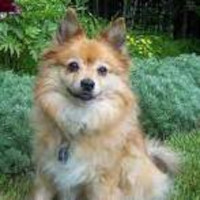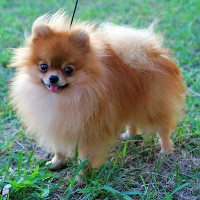Appearance of the Pom-Shi
|
| The Pom-Shi hybrid is a hybrid mix of German Toy Spitz / Pomeranian and Shiba and, as such, can inherit appearance traits from one or both parent breeds. Your furry family member will measure between 15 and 43 centimeters at the shoulders, weighing from 1.5 to 10.5 kilos, depending on which parent breed has the most influence in the biological mix. She will probably have a soft, thick plush coat that has a rough fur line along the spine and is white and red, red, sesame, cream, white, beige and white agouti. Her feet will be small and she will be quite agile, her gait very feline and regal in movement with her short, fluffy tail curled over her back. Dark, almond-shaped eyes, a black nose, a small, narrow muzzle and erect ears complete the alert, intelligent expression. |
Temperament of the Pom-Shi
|
| Your Pom-Shi hybrid is a mix of German Toy Spitz / Pomeranian and Shiba and can inherit temperament qualities from one or both parent breeds. Your Pom-Shi will be playful, energetic, lively, affectionate, gentle and cuddly. He'll be protective of his human family, but you need to be careful with children. He can be chilly, and it's highly recommended that he be socialized as early in life as possible to moderate this trait. He's a barker, which is a major problem if you live in a noise-restricted area. He has a yappy voice type and readily barks at strangers or anyone who approaches. He also barks at anything unusual. While these are good traits for those interested in the guard dog type of canine family member, it may take firm, positive training to limit this for those who need to adhere to a noise level limitation. He has moderate energy levels that will need to be managed to keep him healthy, fit and happy. He gets intelligence and independence from both sides of the biological mix and, while this makes him an excellent family dog, it can also make him moderately difficult to train. It's best to keep his training periods short and fun, as this will reduce the risk of boredom creeping into those training periods. A bored dog is one in which annoying destructive behaviors can develop, something no dog owner wants to deal with. |
Needs and activities of the Pom-Shi
|
| Your Pom-Shi hybrid has a moderate amount of energy that comes naturally and will need to be managed. He'll love those long daily walks, daily romps and playtime in the dog park or fenced-in backyard, as well as those interactive games of fetch, Frisbee and hide-and-seek with his toys inside or outside the house. Because he's small to medium-sized, he can adapt to apartment or condo living, provided his exercise needs are met. They are equally at home in family homes with or without fenced yards, in urban or rural settings. Temperate climates suit it well. |
Maintenance of the Pom-Shi
|
| Your Pom-Shi hybrid is a moderate maintenance dog. The shedding of this hybrid is considered low. It will require brushing at least once a week to remove loose hair, mats and debris. Brushing frequency will depend on hair length, which is ultimately determined by the parent with the greatest influence in the organic mix. He should have his ears checked weekly and cleaned as needed with a cotton ball and an approved canine ear cleaner. Also be sure to check his nails weekly, trimming them as needed, unless his physical activities are wearing them down. As with other canine breeds, his teeth need attention and should be brushed two to three times a week, in addition to regular dental check-ups and cleaning by your veterinary professional. He falls into the low odor and drooling dog categories. |









 English (United Kingdom)
English (United Kingdom)